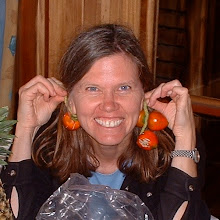Last week I tried out a very different kind of temari, those in which many threads are wrapped around the ball instead of stitched on to it. Each hemisphere of the temari has the same pattern.
I found the patterns in the archives of the Temari Challenge group. The balls aren't as complicated to make as they look. They just need a simple 4 division. (That's the easiest division there is.) Because there isn't any stitching other than tacking down the end of a thread, I found them quite easy. For this pattern, a square and a cross was established by measuring along the division lines. Threads are wrapped alternately on the square and the cross and pass between keeper pins at the equator. Later the threads between the keeper pins are bundled securely by sewing around them.
Magically, a pattern builds up that looks like a quilt. (It might have been more magical and certainly would have developed more quickly if I had something other than sewing thread to work with; it was good I was fascinated by the progress because it took a long time.) I like the way it looks where all the threads are bundled together. The band around the middle is called the obi, like the belt on a kimono.
The second quilt temari I did also used a simple four division but those lines were divided ten times at a spacing of 1 cm. This is the largest temari I have made so far, having a circumference of about 30 cm. (12 inches). Even with my long fingers it was a bit hard to manipulate as I circumnavigated the sphere with thread.
I made a little change compared to the pattern in that I because I got mixed up on where to place my first wraps. It was a fortuitous mistake though because I ended up with a bilaterally symmetrical pattern.
One thing I like about these temari is that sometimes it looks like they aren't round: from this angle it looks a bit squashed to me, but it really is a sphere. I plan to explore other patterns from the archive.
I found the patterns in the archives of the Temari Challenge group. The balls aren't as complicated to make as they look. They just need a simple 4 division. (That's the easiest division there is.) Because there isn't any stitching other than tacking down the end of a thread, I found them quite easy. For this pattern, a square and a cross was established by measuring along the division lines. Threads are wrapped alternately on the square and the cross and pass between keeper pins at the equator. Later the threads between the keeper pins are bundled securely by sewing around them.
Magically, a pattern builds up that looks like a quilt. (It might have been more magical and certainly would have developed more quickly if I had something other than sewing thread to work with; it was good I was fascinated by the progress because it took a long time.) I like the way it looks where all the threads are bundled together. The band around the middle is called the obi, like the belt on a kimono.
The second quilt temari I did also used a simple four division but those lines were divided ten times at a spacing of 1 cm. This is the largest temari I have made so far, having a circumference of about 30 cm. (12 inches). Even with my long fingers it was a bit hard to manipulate as I circumnavigated the sphere with thread.
I made a little change compared to the pattern in that I because I got mixed up on where to place my first wraps. It was a fortuitous mistake though because I ended up with a bilaterally symmetrical pattern.
One thing I like about these temari is that sometimes it looks like they aren't round: from this angle it looks a bit squashed to me, but it really is a sphere. I plan to explore other patterns from the archive.









5 comments:
Your temari balls are extraordinarily beautiful! Thanks for sharing your developing projecy.
Stunning - I'm so impressed with your skills and creativity!
Thanks Gail and Asplund!
These are insanely beautiful!
Hola, mi nombre es Jimena.. El link que pusiste para el priner temari, ya no está disponible. Tendrias un diagrama o tutorial ? Mi inglés no es bueno...
Muchas gracias..mi página de face es jimena candia alquimia japonesa. Saludos desde Argentina
Post a Comment